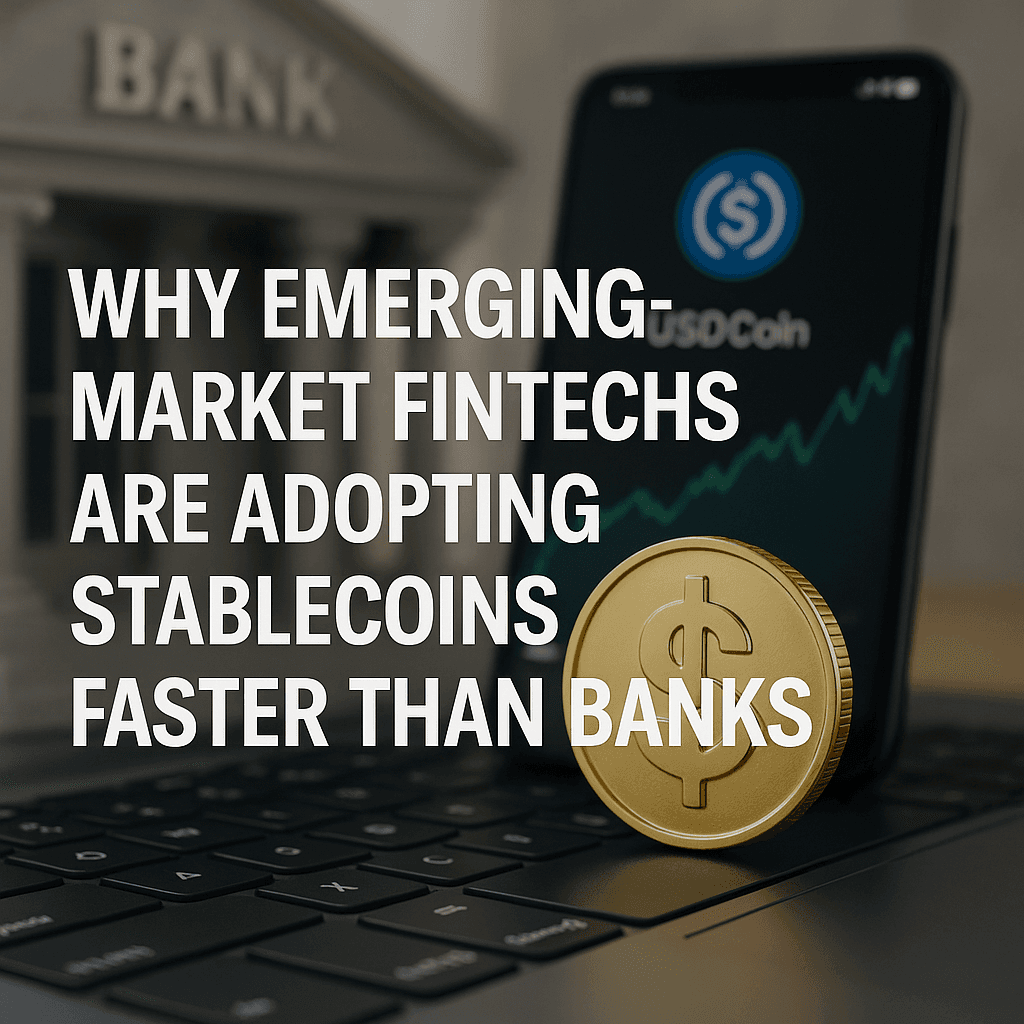The stablecoin revolution is happening in Latin America and Africa, not Wall Street boardrooms. While major banks debate regulatory frameworks, emerging market fintechs process billions in daily stablecoin transactions and reshape regional financial systems.
The numbers are striking. Stablecoin adoption in emerging markets doubled between H2 2024 and H1 2025. In Latin America, stablecoins represent over 50% of all exchange purchases for major currencies. Sub-Saharan Africa saw 43% of crypto transaction volume attributed to stablecoins in 2024, with Nigeria alone processing $22 billion.
What drives this adoption gap? Three structural advantages give emerging market fintechs speed that traditional banks cannot match.
The Economic Driver: Solving Real Problems Today
Currency Instability Creates Immediate Demand
Emerging market fintechs deploy stablecoins to solve urgent financial challenges that traditional banking fails to address. The macroeconomic context creates undeniable demand.
Latin America's Currency Crisis:
Venezuela: 47% inflation in 2024
Argentina: 117% inflation, 61.8% stablecoin usage rate
Brazil, Colombia, Mexico: Double-digit currency depreciation
Africa's Foreign Exchange Shortage:
70% of African countries face FX shortages
Nigeria's naira devalued dramatically post-2023
Ethiopia's birr lost 30% value after 2024 float
Chainalysis research confirms direct correlation between currency devaluations and stablecoin adoption. When local currencies lose value weekly, stablecoins transition from innovation to necessity, providing dollar-linked stability for savings, commerce, and cross-border transactions.
Cross-Border Payments: 60% Cost Reduction
Traditional cross-border systems impose crushing costs. Sub-Saharan Africa faces the world's highest remittance fees, often double global averages. Latin American businesses routinely pay 3-4% for transfers taking 3-5 days.
Fintechs use stablecoins to cut costs by 60%+ while offering instant settlement:
Latin America Impact:
71% cite cross-border payments as primary use case (vs. 49% globally)
Payment aggregators grew 68% in H1 2025
Gaming sector increased 5.3x in stablecoin payments
Africa's Results:
Yellow Card: 99% of transactions involve stablecoins
30,000+ businesses across 20 countries
$6 billion+ total volume processed
These aren't pilot programs. They're operational infrastructure serving real economic activity at scale.
Why Fintechs Move 2x Faster: The Structural Advantages
Speed Advantage: 3-6 Months vs. 12-18 Months
Decision cycle velocity creates compounding advantages. Banks navigate compliance committees, risk frameworks, and board approvals over 12-18 months. Fintechs deploy new infrastructure in 3-6 months.
This speed matters in rapidly evolving markets. Fintechs that integrated stablecoin rails in early 2024 now process daily volumes that would take banks years to achieve.
Fintech Speed Factors:
Flat organizational structures enabling rapid decisions
Technology-first architectures built for integration
Quarterly vs. annual planning cycles
Direct customer feedback loops
Regulatory Flexibility: Operating with Confidence
Only 29% of Latin American institutions cite regulatory uncertainty as an adoption barrier, compared to 41% globally. Just 7% mention lack of expertise, the lowest of any region.
Banks must navigate comprehensive charters, capital requirements, and conservative risk frameworks. Fintechs operate with structural flexibility, testing product-market fit in favorable jurisdictions and expanding as regulations clarify.
Regional Examples:
South Africa: 59 crypto licenses approved March 2024
Nigeria: Working group studying stablecoin integration
Brazil: 2022 Crypto Assets Law providing clear framework
Kenya: Leveraging M-Pesa for stablecoin integration
Infrastructure Readiness: Built for Digital Assets
Emerging market fintechs started with infrastructure designed for the digital economy, not retrofitted from decades-old core banking systems.
Latin America Readiness:
86% report partnerships supporting stablecoin integration
71% confirm infrastructure ready (wallets, APIs)
75% note growing customer demand
Africa's Foundation:
Kenya's M-Pesa handles 60% of GDP
Nigeria ranks second globally in crypto adoption
South Africa's clear regulatory environment
When Bancolombia launched peso-backed stablecoin COPW through Wenia, it leveraged existing digital infrastructure for immediate retail reach. BRL1 in Brazil connected directly to exchange flows through established fintech networks.
Compare this to banks integrating blockchain with ISO 20022 standards from 2004 lacking support for on-chain settlement or smart contracts.
Regional Leaders: Execution at Scale
Latin America: Operational Infrastructure
Latin America processed $47.9 billion in crypto volume by June 2025, with stablecoins dominating major economies.
Brazil ($318.8B in crypto value received):
Nearly one-third of LATAM activity
BRL1 stablecoin enabling direct exchange flows
Clear regulatory framework driving adoption
Mexico (45-47% of regional volume):
Critical US-Mexico remittance corridor
Payment aggregator growth of 68%
Mature fintech ecosystem
Argentina ($93.9B transaction volume):
61.8% stablecoin usage vs. 44.7% globally
Most advanced regulation in region
Grassroots adoption leading institutional
The pattern: fintechs identify use cases, build infrastructure rapidly, scale before banks complete feasibility studies.
Sub-Saharan Africa: Fastest-Growing Frontier
Africa recorded 52% growth in on-chain value between July 2024-June 2025, with retail activity leading globally at over 8% of transfers under $10,000.
Nigeria (Second globally in adoption):
$56 billion annual crypto trading volume
60% in stablecoins (USDT, USDC)
40% adult population using crypto
Central Bank studying integration
Kenya (Mobile money bridge):
90% adult population using M-Pesa
60% of GDP through mobile money
East African hub positioning
Ethiopia (Fastest-growing market):
180% year-over-year growth
Currency float driving adoption
Yellow Card reports stablecoin adoption driven by "most practical" use cases: treasury management, payroll, supplier payments under $1,000 for real-world needs.
Why Banks Cannot Compete at This Speed
The adoption gap reflects fundamental structural differences in operations, risk assessment, and customer service.
Legacy System Constraints
Traditional banks operate on core systems often decades old, designed for batch processing and correspondent banking networks. Integrating blockchain requires extensive middleware and complex integration work taking years.
ISO 20022, widely adopted by 2023 after 2004 introduction, lacks fundamental digital asset support: no on-chain settlement tags, no wallet address support, no smart contract framework.
Fintechs bypass this by building on modern, cloud-native architectures with API-first designs from day one.
Risk Management Frameworks
Bank risk frameworks prioritize stability over innovation velocity. Every product requires extensive assessment, committee approvals, and capital allocation. Stablecoins introduce novel risks traditional models struggle to quantify.
Fintechs deploy minimum viable products, iterate based on usage, scale what works. This experimental mindset enables rapid testing banks would spend months evaluating.
Deposit Protection Concerns
Banks view stablecoins as deposit flight risk. If customers hold stablecoins earning yield through DeFi protocols, why maintain traditional accounts earning minimal interest?
Fintechs don't face this conflict. Many don't hold banking licenses, partnering for compliance while building innovative products. They're free to offer whatever customers demand without deposit base concerns.
The Infrastructure Opportunity
The adoption gap creates massive infrastructure opportunities. Fintechs need programmable infrastructure traditional payment providers don't offer.
What Emerging Market Fintechs Need
Yield Optimization: Every balance should earn 6-9% APY through DeFi integration. Banks are prohibited from offering yield on stablecoin holdings under frameworks like the GENIUS Act.
Programmable Workflows: B2B payments need milestone releases, conditional logic, automated compliance. Smart contracts enable impossible capabilities with traditional rails.
Cross-Chain Orchestration: Unified infrastructure working seamlessly across Solana, Ethereum, Polygon without separate integrations.
Regulatory Compliance: Automated Travel Rule compliance, KYC/AML integration, reporting capabilities embedded rather than bolted on.
RebelFi's Solution
RebelFi builds the missing on-chain layer enabling truly programmable money while providers like BVNK and Bridge focus on fiat rails.
Key Capabilities:
Instant yield generation: 6-9% APY from transaction arrival
Smart payment infrastructure: Reversible transfers, programmable escrow
Single integration point: One API for yield, cross-chain, compliance
Aligned revenue model: Yield sharing instead of transaction fees
For Latin American and African fintechs processing significant daily volumes, this infrastructure transforms payment operations from cost centers into revenue generators while maintaining competitive speed advantages.
Market Validation: Real Numbers
Evidence isn't anecdotal. Major regional players report transformative numbers:
Bitso Business (LATAM):
Stablecoin share doubled H2 2024 to H1 2025
FX, treasury, arbitrage = 45% of volume
1,300+ institutional clients
Yellow Card (Africa):
99% of transactions involve stablecoins
30,000+ businesses, 20 countries
$6 billion+ processed
Flutterwave (Africa):
CEO projects "10x the volumes we're doing"
48% received payments from new geographies in 2024
34 US Money Transmitter Licenses by H1 2025
These represent operational infrastructure processing billions in actual economic value.
The Widening Gap
The adoption gap isn't narrowing, it's accelerating.
Regulatory Momentum Favors Fintechs
US GENIUS Act:
Federal framework provides clarity
Banks custody stablecoins without balance sheet impact
But banks prohibited from offering yield
Creates partnership opportunities with infrastructure providers
Regional Evolution:
Nigeria studying integration via Central Bank working group
South Africa's clear framework driving investment
Brazil's 2022 law providing regional template
Network Effects Compound Advantages
Fintechs with 2024 stablecoin infrastructure now possess network effects making them difficult to displace:
Customer lock-in with significant switching costs
Liquidity pools enabling better pricing
Partnership ecosystems with issuers and networks
Developer communities building value-added services
Infrastructure Determines Winners
Next-phase competition won't be about basic acceptance. The advantage comes from programmable infrastructure enabling new financial capabilities:
Treasury optimization with automated yield
Smart escrow with conditional payments
Cross-border intelligence for optimal routing
Embedded compliance traveling with transactions
Yield distribution between payment flow parties
Fintechs building on programmable platforms like RebelFi offer capabilities banks using traditional rails cannot match.
Conclusion: The Transformation Is Here
The data proves emerging market fintechs adopt stablecoins at 2x bank velocity. Latin America processed $47.9 billion by mid-2025 with stablecoins dominating. Sub-Saharan Africa saw 52% growth with 43% attributed to stablecoins.
The Five Drivers:
Economic necessity: Currency volatility creates immediate demand
Structural agility: 3-6 month vs. 12-18 month cycles
Infrastructure readiness: Digital-native from day one
Regulatory flexibility: Comfort operating as regulations mature
Customer alignment: No deposit flight concerns
Traditional banks face constraints preventing matched adoption pace: legacy systems, risk frameworks, organizational cultures, deposit protection concerns.
The infrastructure opportunity is massive. Emerging market fintechs need programmable platforms enabling yield generation, smart workflows, cross-chain capabilities, embedded compliance. Companies building this infrastructure today position themselves at the center of financial transformation.
For fintech leaders in these regions, the question isn't whether to adopt stablecoins. It's whether to build infrastructure partnerships now or risk falling behind competitors already generating revenue from programmable money while banks continue pilot programs.
The transformation isn't coming. It's already here. And emerging market fintechs are leading it.
RebelFi provides programmable stablecoin infrastructure enabling emerging market fintechs to offer yield generation, smart payments, and automated compliance through a single API integration. Learn more at rebelfi.io.



